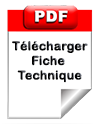Plus petite grive indigène du Paléarctique occidental, la grive mauvis se distingue aisément des autres à son sourcil et son demi-collier beige pâle et à ses flancs et les plumes sous alaires roux …
Grive Mauvis
En Vol
Grive Mauvis
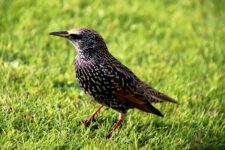
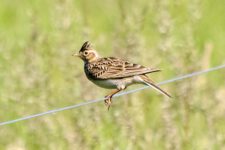
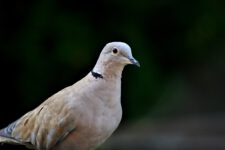
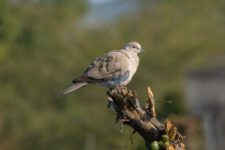
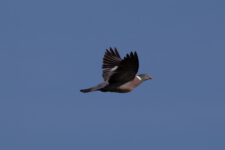
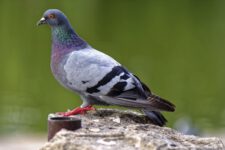
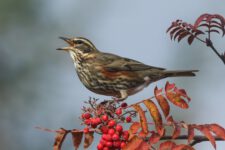
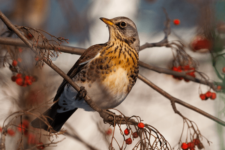
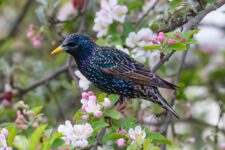
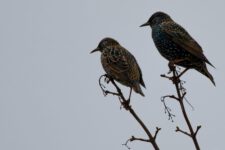
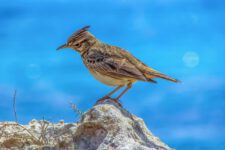
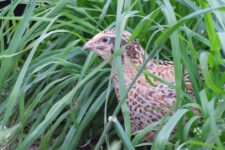
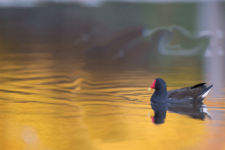
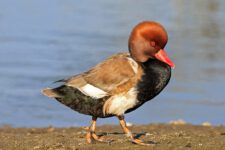
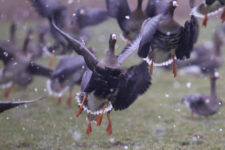
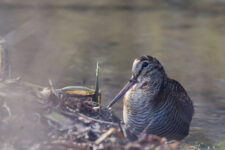
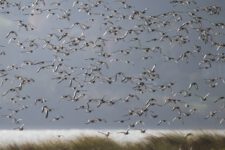
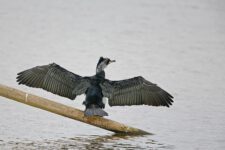
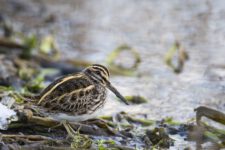
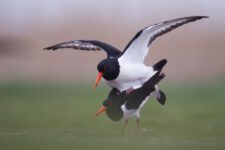
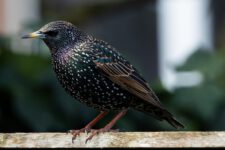
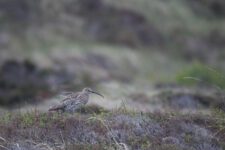
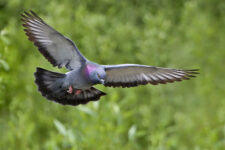
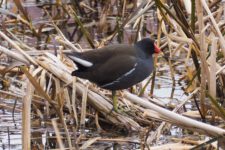
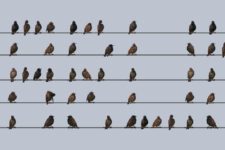
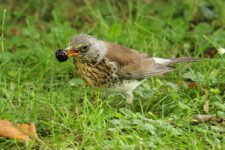
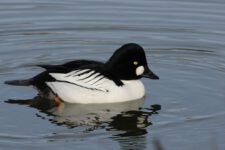
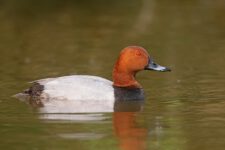
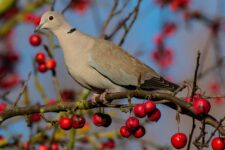
Fiche technique réalisée par Jean Claude Ricci directeur de l’IMPCF
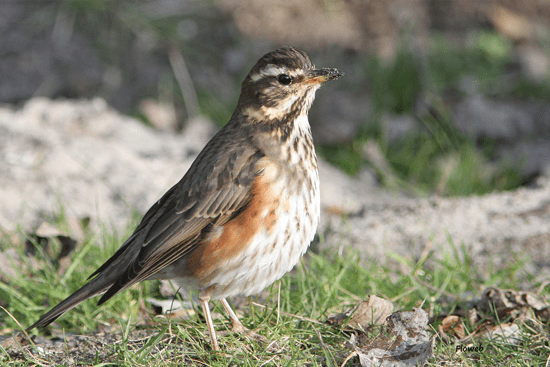
Photographié par : Florian Weber
Espèce : Turdus iliacus (L.1766) : Grive mauvis – Redwing- Zorzal Alirrojo-Tordo sassello
Directive 79/409 : Annexe II-2
Convention de Bern : Annexe III
Convention de Bonn : Annexe II
Etat de conservation en Europe : SPEC : catégorie 4 (favorable)
Statut en Europe : Sécurisé
Description et Identification
Plus petite grive indigène du Paléarctique occidental, la grive mauvis se distingue aisément des autres à son sourcil et son demi-collier beige pâle et à ses flancs et les plumes sous alaires roux. Ce critère distinctif est très bien observé en vol. Elle mesure 21cm et a une envergure moyenne de 33-34.5cm. Les deux sexes sont identiques. On distingue de légères variations géographiques et notamment deux » sous espèces ou races » : T.i.coburni (Islande ; Iles Feroes) ; un peu plus grande que T.i.iliacus (Nord de l’Écosse ; Scandinavie et Nord de la Russie jusqu’à l’Est de la Sibérie, Lac Baïkal ; pas plus au sud que la Pologne et le sud de l’Ukraine). Des 4 espèces de grives chassables en Europe, la grive mauvis est celle dont la répartition est la plus septentrionale. Les deux races présentent de légères différences de coloration : T.i.coburni, est un peu plus sombre.
Selon (3) : planche 74.
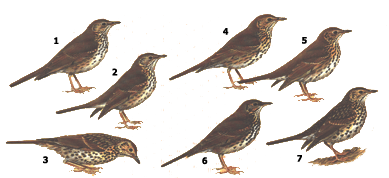
Turdus p.philomelos : 1 = Adulte (printemps) : 2 = Adulte (1er automne) : 3 = Juvénile.
Turdus.p.clarkei : 4 = Adulte (printemps) : 5 = Adulte ( 1er automne).
T.p.hebridensis : 6 = Adulte (automne) : 7 = Juvénile.
Le poids varie selon la saison et les localités géographiques occupées par les « sous-espèces ou races » : T.i.iliacus : automne : 68.4g ; été : mâle : 62-74g : femelle : 71-73g ; printemps : mâle : 58-68g, femelle : 52-77g. T.i.coburni : printemps : mâle :66-88g ; femelle : 70-74g ; septembre-octobre : 71g.
Elles se distingue des autres espèces notamment par sa taille et notamment de la grive musicienne par son vol plutôt semblable à celui de l’étourneau sansonnet (Sturnus vulgaris) et par le dessous des ailes roux (planches 24 et c , selon 2) qui lui a valu son nom en anglais (redwing) et en espagnol (zorzal alirrojo).
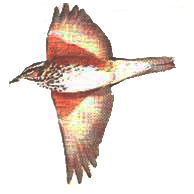
Grive Mauvis en vol


Aile de Grive Musicienne
Aile de Grive Mauvis
Répartition Géographique
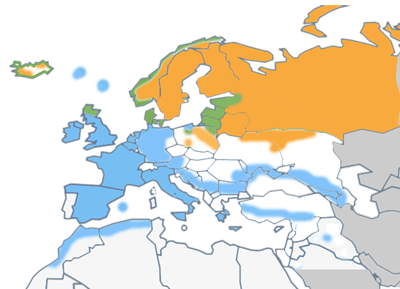
 : Espèce présente toute l’année
: Espèce présente toute l’année
 : Présente en été
: Présente en été
 : Hôte hivernal
: Hôte hivernal
Répartition géographique des «sous-espèces ou races « : T.i.iliacus a une répartition discontinue et variable en nombre du nord de l’Ecosse à la Scandinavie et au nord de la Russie. La plupart des populations nicheuses se situent entre 50° et 73° de latitude nord. Plus au sud, plusieurs populations partiellement isolées se situent en Pologne et dans le sud de l’Ukraine et une partie des républiques Baltes. T.i.coburni est présente en Islande, aux Iles Féroé. Cette sous espèce a niché au sud du Groenland en 1948 et en 1967. En 1990/1991 une petite population se serait installée au sud du Groenland.
Détermination de l’âge et chronologie de la mue : les adultes réalisent une mue complète après la reproduction (primaires descendantes), soit de fin juin à fin septembre. La mue dure 52 à 61 jours à 61° de latitude nord et 40 jours à 70°.La mue est complète avant le départ en migration. Les jeunes muent aussi avant le départ en migration avec quelques parties incomplètes : tête, corps, couvertures… L’âge est déterminé par l’examen des grandes couvertures et des rémiges
Jeune
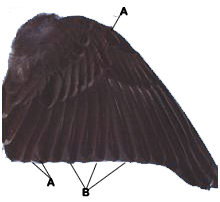
A : Grandes couvertures et une ou deux rémiges tertiaires avec à l’extrémité, une tâche blanche apicale et triangulaire très marquée.
B : Extrémités des rémiges plus arrondies que chez l’adulte.
Adulte
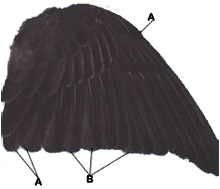
A : Les grandes couvertures et les rémiges tertiaires présentent une couleur plus uniforme et une tâche blanche plus discrète en demi-lune mais pas triangulaire.
B : Extrémités des rémiges moins arrondies et défraîchies que chez le jeune.
Habitat et Alimentation
Espèce commune voire localement abondante qui niche dans plusieurs types de bois : résineux, bouleaux arctiques, localement dans les parcs et le jardin en Islande et en Scandinavie, haies avec des grands arbres. En Russie elle se reproduit à proximité des zones ouvertes des grandes forêts (zones brûlées, coupes de bois), dans la toundra et la taïga. En Écosse, des individus ayant récemment colonisé cette partie de l’aire de distribution, nichent au sol dans de grandes propriétés, dans les haies et dans des milieux variés où alternent des milieux ouverts à proximité de couvert. En migration elle fréquente surtout les milieux ouverts mais aussi en lisière de forêts, dans les parcs et les jardins surtout par grand froid. En hiver elle utilise les zones cultivées, les grandes pâtures bordées de bois et de haies. En Belgique, lors d’hivers rigoureux on a pu remarquer de fortes concentrations sur la côte sans pour autant constater une forte mortalité pour des vagues de froid ne dépassant pas une semaine. Au Maroc, pendant l’hivernage, des groupes de plusieurs centaines d’oiseaux sont observés dans les vergers du Haut Atlas, dans les oliveraies des Hauts Plateaux et dans les cédraies.
Bien qu’étant sans doute la moins résistante des grives du Paléarctique occidental, soumise à des cas de mortalité massive, la grive mauvis, maintient des populations élevées grâce à sa forte capacité à occuper des niches écologiques vacantes, tant au nord qu’au sud de son aire annuelle de répartition, et à utiliser une nourriture variée et à effectuer de grands déplacements pour la trouver. Elle consomme une grande variété d’invertébrés, des mollusques dont elle casse la coquille avec son bec ou sur un rocher comme la grive musicienne. Elle cherche aussi sa nourriture dans la litière comme dans les déjections de bétail : fourmis, myriapodes, vers de terre, araignées. Le long des côtes, elle est capable de consommer de petits crabes et des vers marins. Elle consomme la plupart des baies forestières (myrtilles, genièvre, sorbes, ..) et les fruits (pommes tombées au sol). En zone méditerranéenne, elle consomme des olives, du raisin et de nombreux insectes nuisibles aux cultures. Le régime alimentaire des jeunes au nid se compose essentiellement de vers de terre (77-96% en Suède ; 67% en Finlande) mais aussi d’autres invertébrés (Diptères, larves de Lépidoptères).
Reproduction
La reproduction (ponte) commence à la mi-mai en Islande et en règle générale pas avant la fin avril. Le site de ponte est soit au sol (28%), dans les arbres (34%) , dans les souches (17%), dans les buissons de genévrier (13%) et au sol sous un buisson de genévrier (8%). L’espèce niche en colonie, quelquefois avec d’autres espèces comme la grive litorne (Turdus pilaris) et l’étourneau sansonnet (Sturnus vulgaris). Sur 360 nids contrôlés dans la même zone , 45% se trouvaient à moins de 10cm au dessus du sol , 14% entre 10-50cm , 23% entre 0.5-1m , 13% entre 1 -2m , 3% entre 2-3m et 3% seulement au dessus de 3m.
Le nid est construit par la femelle avec des brindilles, des feuilles, de la mousse assemblées avec de la boue. Le diamètre extérieur du nid est 13.5 cm (11.5-16.0), le diamètre intérieur de 8.4cm (6.8-9.5), hauteur de 9.3 cm (7.0-11.0) et la profondeur de 5.4cm (4.5-6.8). Les œufs (planche suivante, selon 3), sont sub-elliptiques, lisses et légèrement bleutés avec de nombreuses mouchetures rousses . Les œufs en moyenne mesurent 29 x 21 mm et pèsent en moyenne 14.9 g chez T.i.iliacus et 15.5 g chez T.i.coburni.

La taille des pontes varie de 4 à 6 œufs (3-7). L’examen de 261 pontes en Suède a permis de connaître la distribution suivante : 4 œufs dans 4% des cas ; 5 dans 40% ; 6 dans 53% ; 7 dans 3%. En règle générale, la grive mauvis réalise deux pontes mais aussi une ponte de remplacement en cas de destruction. La fréquence de ponte d’un œuf est de 24h. L’incubation dure 12.7 jours en moyenne (12-13), est réalisée par la femelle mais le mâle peut entrer dans le nid quand celle-ci s’absente pour se nourrir. Les poussins sont nourris par les deux parents. L’envol se situe en moyenne à 10jours (8-12) en moyenne après l’éclosion. Les jeunes sont indépendants environ 14 jours après l’envol. Le mâle continue à nourrir les jeunes de la première nichée alors que la femelle est en train de couver la deuxième ponte. L’âge à la première reproduction n’est pas très bien connu mais il se situerait, comme pour les autres grives, à un an. Le succès de la reproduction dépend du taux de prédation sur les nids. Une étude Suédoise portant sur 259 nids, révèle un taux de destruction de 32% essentiellement du à des corneilles. Sur 286 œufs contrôlés, 81% ont éclos. Parmi les 181 poussins, 69% ont vécu jusqu’à l’envol, soit un succès global de 62.1%. En Finlande, sur 285 œufs, le taux d’éclosion est de 69%. Sur les 197 jeunes éclos et individuellement suivis, 73% ont survécu jusqu’à l’envol soit un succès total de 50.5%
Populations
Une synthèse européenne récente (5) estime les effectifs européens entre 16 et 21 millions de couples (15 pays concernés). Les effectifs les plus importants se situent en Russie (12 à 15 millions de couples) ; Finlande (1.5 à 2.5 millions de couples) , en Norvège (1 à 1.5 million). Les autres pays accueillent moins d’un million de couples chacun. Les tendances actuelles selon les normes du Bird Life International et de l’UICN permettent de classer l’espèce en catégorie 4 : état de conservation favorable et statut sécurisé en Europe. L’espèce est stable ou en augmentation dans 9 d’entre eux notamment dans ceux abritant les ¾ des effectifs européens. En raison des modifications climatiques, on peut envisager l’hypothèse d’un glissement progressif des populations nicheuses vers le sud de l’Europe mais cela est une hypothèse qu’il conviendra de vérifier par un suivi de son aire de reproduction.
Si l’on admet une production moyenne de 2 jeunes par couple avant le départ en migration, les effectifs totaux se situeraient entre 64 et 84 millions d’oiseaux avant le départ en migration post nuptiale. Les estimations faites antérieurement dans les années 2000 situaient la population européenne entre 20 et 26 millions d’individus soit le tiers environ (6).
Taux de mortalité : En Finlande le taux global de mortalité a été estimé à 57-58%. Le plus vieil oiseau bagué connu était âgé de 18 ans et 9 mois.
Mouvements dans le Paléarctique Occidental
Les différentes populations sont migratrices strictes ou partielles. A titre d’exemple, les oiseaux se reproduisant en Sibérie orientale parcourent environ 6500 Km pour rejoindre leurs zones d’hivernage. La » race » coburni hiverne en Ecosse, Irlande, dans l’ouest de la France et dans la Péninsule Ibérique. La » race » iliacus hiverne dans l’ouest de l’Europe, sur les côtes norvégiennes, le sud-est de la Baltique, et autour de la Méditerranée, Mer noire et Mercaspienne. Les oiseaux hivernant dans ces trois dernières zones proviennent, selon les reprises de bagues, notamment de la Finlande. La migration post nuptiale à partir de la Suède et de la Norvège débute fin septembre et se termine en mi novembre, quelquefois en décembre. Seul un petit nombre d’oiseaux originaires de Scandinavie hivernent en Asie mineure, en Mer Egée et Mer caspienne. Les jeunes oiseaux originaires d’Estonie et de Leningrad se déplacent vers le sud ouest et l’ouest-sud ouest pour hiverner de l’Angleterre au Portugal et dans le sud de l’Italie. Dans le nord de la Russie, les oiseaux débutent leur migration en moyenne la première décade d’octobre et atteignent la Péninsule ibérique en novembre et quelquefois pas avant Janvier selon les conditions météorologiques. Certains travaux suggèrent que l’Espagne et le Royaume Uni accueillent prés de 75% des populations européennes hivernantes (in 5).
Selon des travaux de 1981 (in 3), les mêmes couloirs de migration sont empruntés en automne et au printemps. La grive mauvis réalise ses déplacements migratoires la nuit mais aussi le jour en groupes relativement nombreux en émettant des cris de contact caractéristiques, fort utiles pour identifier l’espèce lors de l’analyse des bandes magnétiques des stations bioacoustiques. En zone méditerranéenne, la grive mauvis arrive plus tard (fin octobre-novembre) que la grive musicienne. Les stations bioacoustiques fonctionnant toutes les nuits et simultanément au nord de l’Italie (Arosio-Udine) et dans le sud de la France (IMPCF : 6 à 14), montrent que les premiers oiseaux en automne survolent l’Italie à partir de la mi-octobre et dans le sud de la France, c’est à la fin de ce mois et notamment en novembre que les passages sont enregistrés. Dans la Péninsule Ibérique et en Afrique du nord, l’espèce arrive en fin novembre, décembre et même en janvier selon les conditions météorologiques. La migration de retour débute à la fin février et surtout en mars (3) et se poursuit en début avril. Ces résultats des années 1970, ont été confirmés et affinés grâce aux stations bioacoustiques et aux dénombrements diurnes couvrant le bassin méditerranéen (IMPCF : 6 à 14) mais aussi par l’étude de l’accumulation lipidique au Portugal (4).
En Norvège, les grives mauvis arrivent de fin mars à mi-avril, dans le nord du Caucase en mars-avril, dans la région de Minsk, au début avril, en Russie, dans la deuxième quinzaine d’avril et dans Oural à la fin d’avril (3 et 18). Deux cas sont cités dans la littérature de reprise d’oiseaux en Amérique du nord en 1959 (in 3).
Chasse-gestion des Populations et des Habitats
La grive mauvis est comme la grive musicienne chassée dans la zone méditerranéenne. On ignore la part des prélèvements en France, puisque l’enquête ONCFS/UNFDC , concernait l’ensemble des 4 espèces de grives chassables. Il en est de même dans d’autres pays concernés par la chasse de cette espèce à l’exception de l’Italie où le carnet de prélèvement prévoit la distinction des espèces contrairement à celui instauré en Grèce.
Les modes de chasse sont similaires à ceux de la grive musicienne avec néanmoins une prédominance du tir au vol à poste fixe en raison des déplacements en groupe assez fréquent et quotidiens chez cette espèce. Elle est traditionnellement capturée à la glue à partir d’un poste fixe (Dérogation : Art 9 de la directive 79/409) dans le sud est de la France et en Espagne, mais contrairement à la grive musicienne, à la cime des arbres où elle a coutume de se poser en groupe.
Le statut de cette espèce est considéré comme favorable en Europe mais son comportement erratique rend son étude difficile. Les fluctuations observées en Europe (5) résultent d’un manque de connaissances qu’il conviendrait de combler conformément aux recommandations de la directive 79/409. L’entrée éventuelle de nouveaux pays dans l’Union européenne permettra de compléter nos connaissances notamment en Europe de l’est.
Comme pour l’ensemble des espèces chassées, il est indispensable de disposer de statistiques relatives aux prélèvements. La généralisation d’un carnet serait souhaitable en prenant soin de séparer les espèces dont le statut peut évoluer indépendamment et de connaître le nombre de sorties de chasse (avec ou sans prélèvement) pour calculer l’effort de chasse.
La conservation des habitats de nidification de la grive mauvis conditionne l’avenir des populations. Cette espèce, la plus nordique des 5 classées gibier dans le genre Turdus, se reproduit dans des conditions météorologiques souvent difficiles y compris même en mai et juin dans les pays scandinaves et d’Europe de l’est. Les principaux habitats à conserver sont les forêts nordiques dont les traitements phytosanitaires sont à surveiller, les formations végétales de bouleaux arctiques et les habitats du type » taïga et toundra « . En outre comme pour les autres espèces de Turdidés, les haies restent des éléments essentiels en zones agricoles pour la reproduction. Dans l’aire d’hivernage, la protection des habitats utiles aux haltes migratoires est indispensable : forêts d’altitudes (feuillus et résineux), prairies d’altitude mais aussi oliveraies et vignes en zone méditerranéenne comme les landes à genévrier (Juniperus sp) et les vergers fournissant à l’espèce une nourriture riche et variée. Comme pour la grive musicienne, le développement des oliveraies soutenu par l’Union européenne devrait être un facteur favorisant la survie hivernale et pré nuptiale.






























